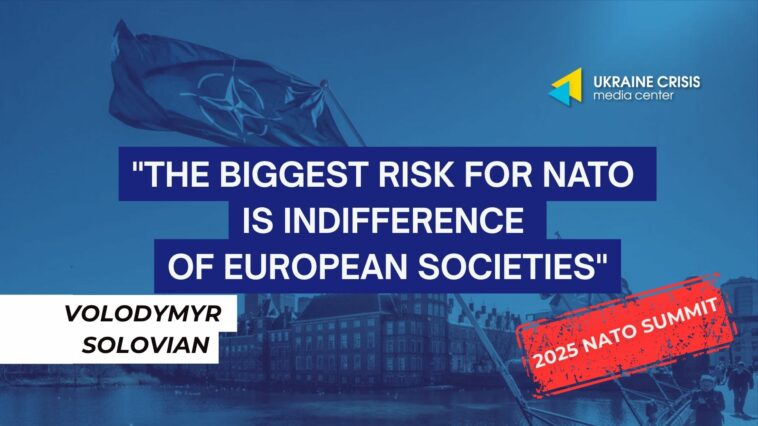Russia retains the capacity to generate hybrid threats and even launch a military attack against NATO member states. This may occur sooner than many European countries expect. The Alliance needs a coherent security strategy – including increased defense spending. But does every country truly grasp the scale of the threat?
This was the topic of an interview on the FREEДОМ TV channel with Volodymyr Solovian, Head of the Hybrid Warfare Analysis Group at the Ukraine Crisis Media Center.
Text version:
Once considered controversial, increased defense spending among NATO countries is now becoming the new normal. So why is it so difficult to set clear deadlines for reaching the 5% of GDP defense target?
Currently, NATO countries are working toward a benchmark of 5% of GDP on defense by 2032. In fact, this conversation isn’t new. Back in 2014, during the Wales Summit, the Alliance agreed to raise defense expenditures to 2% within a decade. That decision was made under completely different circumstances – Europe had not yet experienced full-scale war, and the threat from Russia was not perceived as acute.
However, Russia’s full-scale invasion of Ukraine has reshaped reality, exposing the Alliance’s lack of readiness for conflict on such a scale. NATO is now confronting a state that is effectively waging hybrid war against European countries and is capable of transferring its technological warfighting experience in Ukraine to other border regions – particularly the Baltic states and Scandinavia.
Is there unity within the Alliance today regarding support for Ukraine and the assurance of its security, particularly in financial terms?
The focus now is on forming a long-term strategy. As the United States under Donald Trump increasingly distances itself from its security commitments to Europe, NATO is being compelled to “Europeanize.”
Simultaneously, we are witnessing a shift in U.S. strategic attention toward the Middle East. Under these conditions, the upcoming NATO summit could be overshadowed by the Israel-Iran conflict.
Still, the growing recognition among European political elites of the need to increase defense spending is a crucial development. At the same time, public support for this policy remains limited. Polls indicate that in several EU countries -especially in Southern Europe – even 2% of GDP for defense is seen as excessive. These societies do not perceive a direct threat from Russia, creating political constraints for national governments.
How is the Russian threat perceived in countries that directly border the Russian Federation?
Border states undoubtedly understand the risks. Up to 630,000 Russian troops are deployed in Ukraine. In the event of a ceasefire, some of these forces could be moved to other theaters to project the fear of war onto NATO countries. This paves the way for new escalations.
At present, a direct conventional threat to NATO appears unlikely – during its invasion of Ukraine, the Kremlin demonstrated its conventional military weakness compared to the Alliance’s capabilities. However, the risk of hybrid aggression remains. Russia continues to operate according to the logic of special operations – sabotage missions, political destabilization, and influence-driven information campaigns.
Does NATO as an organization perceive these threats as clearly as the countries bordering Russia do?
At the leadership level—yes. But it must be remembered that NATO does not have its own army. The Alliance consists of national armies, and here lies the conflict between shared strategic goals and national interests.
NATO today faces a critical question: how can European defense be secured in the potential absence of U.S. guarantees? This also raises the issue of developing a European defense-industrial base, as dependence on American weaponry has become a visible vulnerability.
How realistic is the threat of mass drone attacks on European countries?
It is a very realistic scenario. If Russia halts combat operations against Ukraine, it could amass a significant number of drones for use in other theaters. With unrestricted access to Chinese components, Russia is capable of mass-producing unmanned aerial vehicles.
Meanwhile, NATO’s air defense systems are not designed to intercept thousands of low-cost drones in a short timeframe. The Alliance’s doctrine is focused on neutralizing missiles and enemy aircraft. However, there is currently no clear understanding of how to counter a simultaneous large-scale drone assault. That is why Europe must act now – rather than simply plan for budget increases by 2032.
In conclusion: what is the main challenge facing the Alliance?
The core challenge lies in the lack of threat awareness among European societies. The majority of voters in Western and Southern Europe do not perceive the Kremlin as a danger to their personal well-being. As a result, politicians act inertly, fearing electoral losses.
At the same time, the absence of comprehensive public communication campaigns explaining the need for increased defense expenditures risks creating a situation in which public anxieties about vulnerability are answered with votes for populists promising “peace at any cost.”
In this environment, Russia will continue to exploit war-related fears and attempt to manipulate Europe’s political landscape.

